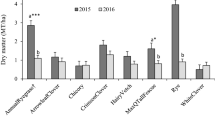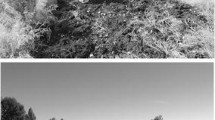Abstract
Native forages of southern United States are frequently low in nutrients and poorly digestible, while improved pastures are the opposite. Since this area produces rapid growth of pines, which is a major use of the land, the integration of pines, pastures, and cattle seem to offer an efficient and economical form of management. Therefore, in a 20-year study Coastal bermuda (Cynodon dactylon), dallis (Paspalum dilatatum), and Pensacola bahia (P. notatum) grasses were grown in pastures with no trees, and with slash pine (Pinus elliottii) spaced 3.7 x 3.7 and 6.1 x 6.1 m. The trees were grown free of competition for 3 years, grasses were established during the 4th year, and grazing by yearling cattle began the 5th year. The pastures were then fertilized, grazed, and burned for 15 years. Increasing tree canopies reduced forage production of all grasses. Bahiagrass was the most shade tolerant, while Coastal bermuda was the least. Liveweight gains during the 15 years of grazing totaled 3933, 2302, and 1518 kg/ha from pastures with no pines and slash pine spaced 6.1 x 6.1 and 3.7 x 3.7, respectively. Survival of slash pine was low due to heavy attacks by southern pine coneworm and southern fusiform rust. However, the trees grew rapidly and averaged 19.0 and 16.9 m in height, 30.0 and 33.3 cm in diameter, and 181.4 and 90.7 m3/ha of pulpwood after 20 years from the 3.7 x 3.7 and 6.1 x 6.1 spacings, respectively. Slash pine at these spacings planted in undisturbed, native vegetation were 16.0 and 15.7 m tall, 19.6 and 23.4 cm in diameter, and produced 145.5 and 63.6 m3/ha of pulpwood. Combining the production of pines and beef on improved pasture offers an opportunity for multiple-product yields. Since this approach to agroforestry is not trouble-free, good management is required. Landowners, especially those with small holdings, should consider these alternatives to single-product management when planning their cropping system.
Similar content being viewed by others
References
Adams SN (1975) Sheep and cattle grazing in forests: A review. J Appl Ecol 12: 143–152
Beveridge AE, Klomp BK and Kowles RL (1973) Grazing in young plantations of radiata pine established clearing logged and reverted indigeneous forest. NZ J For 18: 152–156
Burton GW (1973) Integrating forest trees with improved pastures. In: Range resources of the southeastern United States. Am Soc Agron Spec Publ no. 21, pp 41–49
Burton GW, Jackson JE and Knox FE (1959) The influence of light reduction upon the production, persistence, and chemical composition of Coastal bermudagrass, Cynodon dactyln. Agron J 51: 537–542
Burton GW and Mathews AC (1949) A study of species, seeding methods and and fertilizing practices for use of piney woods ranges. Georgia Coastal Plain Exp Sta Tech Mimeogr Pap 1, 22 p
Gilmore AR and Livingston KW (1958) Cultivating and fertilizing a slash pine
Grelen HE (1953) Forest grazing in the South. J Range Manage 31: 244–250
Halls LK (1953) Improved cattle forage under southern pines. Southern Lumberman 187: 218–220
Halls LK, Burton GW and Southwell BL (1957) Some results of seeding and fertilization to improve southern forest ranges. USDA For Serv SE For Exp Sta Pap 78, 26 p
Halls LK and Suman RF (1954) Improved forage under southern pines.J For 52: 848–851
Hart RH, Hughes RH, Lewis CE and Monson WG (1970) Effect of nitrogen and shading on yield and quality of grasses under young slash pine. Agron J 62: 285–287
Heikkenen HJ (1964) A Dioryctria spp outbreak and its control in a loblolly-slash pine seed orchard. J For 62: 577–579
Hughes RH (1965) Cultivation in pine plantations. In: A guide to loblolly and slash pine plantation management in southeastern USA. Georgia For Res Council Rep 14, pp 287–291
Hughes RH, Hilmon JB and Burton GW (1965) Improving forage on southern pine woodlands. Proc. 9th Int Grassland Cong, pp 1305–1307
Hughes RH and Jackson JE (1962) Fertilization of young slash pine in a cultivated plantation. USDA For Serv SE For Exp Sta Pap 148, 14 p
Hughes RH, Jackson JE and Hart RH (1971) Fertilization of young longleaf pine in a cultivated plantation. USDA For Serv Exp Sta Res Pap SE-75, 8 p
Lewis CE (1977) Longleaf pine responds through age 15 to early fertilization. USDA For Serv SE Exp Sta Res Note SE-239, 7 p
Lewis CE, Lowrey RS, Monson WG and Knox FE (1975) Seasonal trends in nutrients and cattle digestibility of forage on pine-wiregrass range. J Ani Sci 41: 208–212
Lewis CE, McCormick WC and White WE (1972) Cultivation, grazing, insects, and disease affect yield of slash pine planted in sod. USDA For Serv SE For Exp Sta Res Note SE-174, 8 p
20. McKathen G (1980) The Spicer Field story. In: Southern For Range and Pasture Symposium, Winrock Int. New Orleans, La, pp 208–211
National Academy of Sciences-National Research Council (1963) Nutrient requirements of domestic animals. No. 4, Nutrient requirements for beef cattle (revised). NAS/NRC Pub 1137, Washington, DC, 30 p
Peebles LO (1980) Integrated forest and range land use: In: Southern For Range and Pasture Symposium, Winrock Int. New Orleans, La, pp 212–214
Saucier JR (1981) Effects of fast growth rate on wood quality and product yields. In: tech Assoc of the Pulp and Paper Industry Symp Proc, 1981 Annual Meeting, New Orleans, La, pp 435–437
Schmidtling RC (1973) Intensive culture increases growth without affecting wood quality of young southern pines. Can J For Res 3: 565–573
Schopmeyer CS and Smith RH (1955) Pitch moth damage to slash pine. Amer Turpentine Farmer's J 18(3): 10–11
Spurgeon D (1979) Agroforestry: new hope for subsistence farmers. Nature 280: 533–534
Tustin JR, Knowles RL and Klomp BK (1979) Forest farming: a multiple land-use production system in New Zealand. For Ecol and Manage 2: 169–189
Williston HL (1974) Control of animal damage to young plantations in the South. J For 72: 78–81
Wolters GL (1973) Southern pine overstories influence herbage quality. J Range Manage 26: 423–426
Author information
Authors and Affiliations
Additional information
Cooperative study between the Georgia Coastal Plain Experiment Station, University of Georgia, USDA Agricultural Research Service, and USDA Forest Service Southeastern Forest Experiment Station, Tifton, Georgia.
Rights and permissions
About this article
Cite this article
Lewis, C.E., Burton, G.W., Monson, W.G. et al. Integration of pines, pastures, and cattle in south Georgia, USA. Agroforest Syst 1, 277–297 (1983). https://doi.org/10.1007/BF00155936
Issue Date:
DOI: https://doi.org/10.1007/BF00155936




